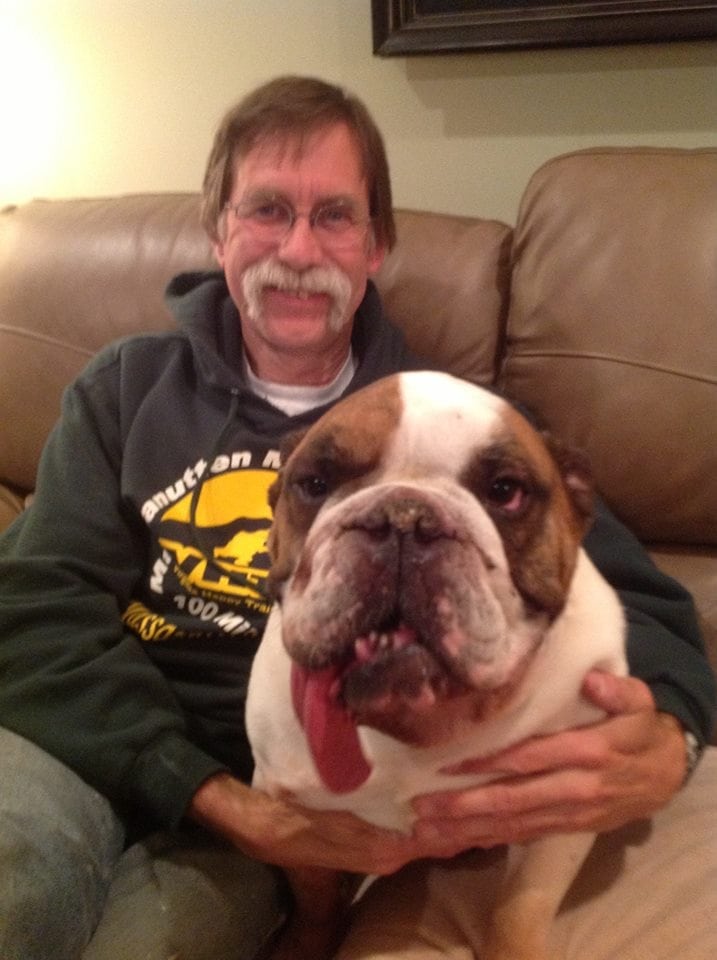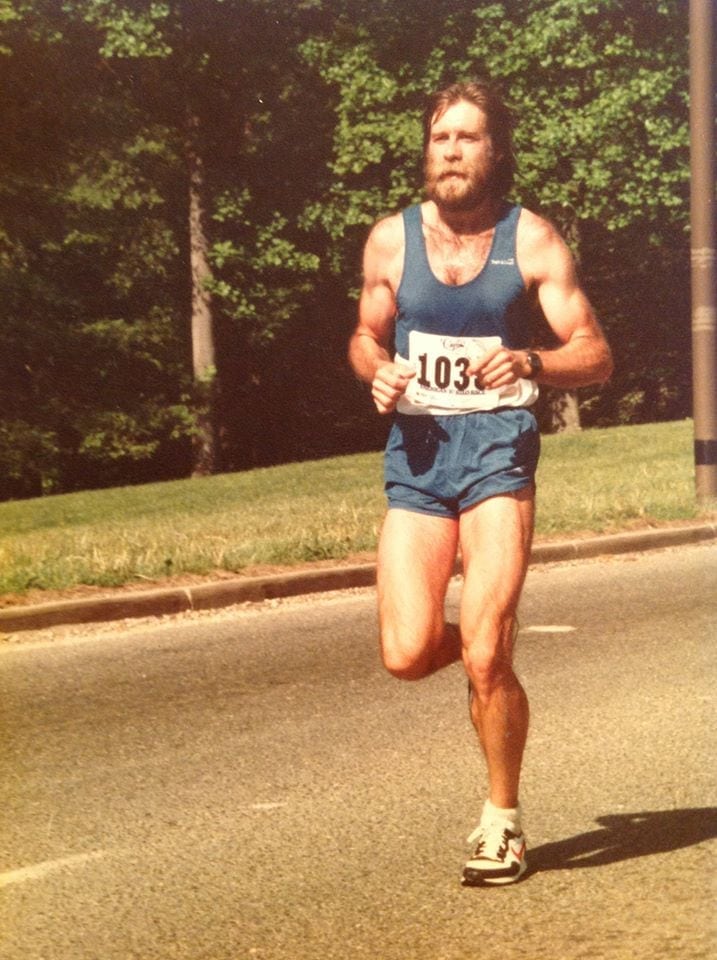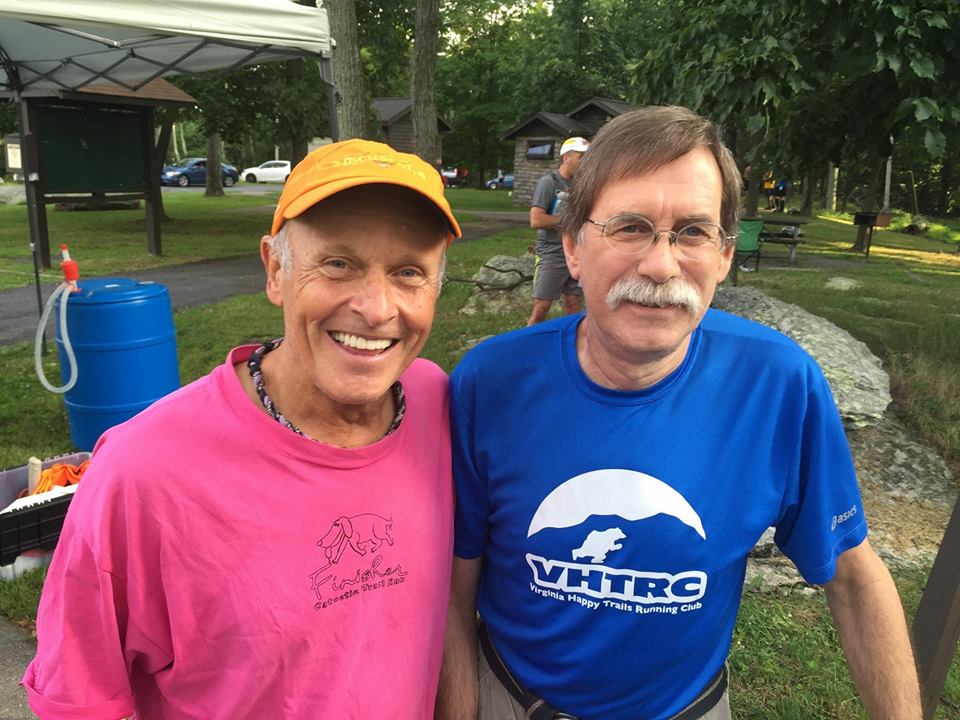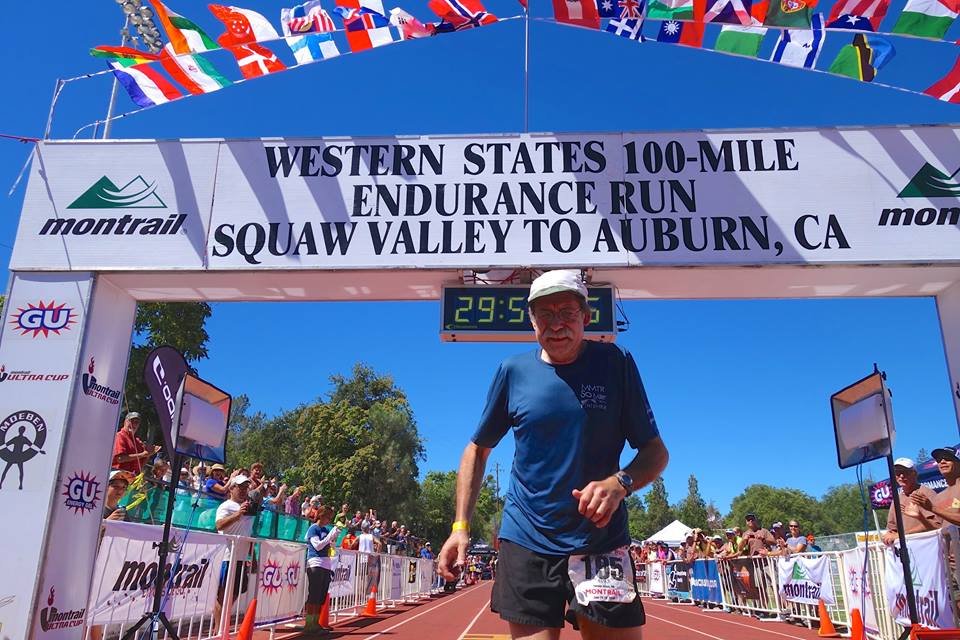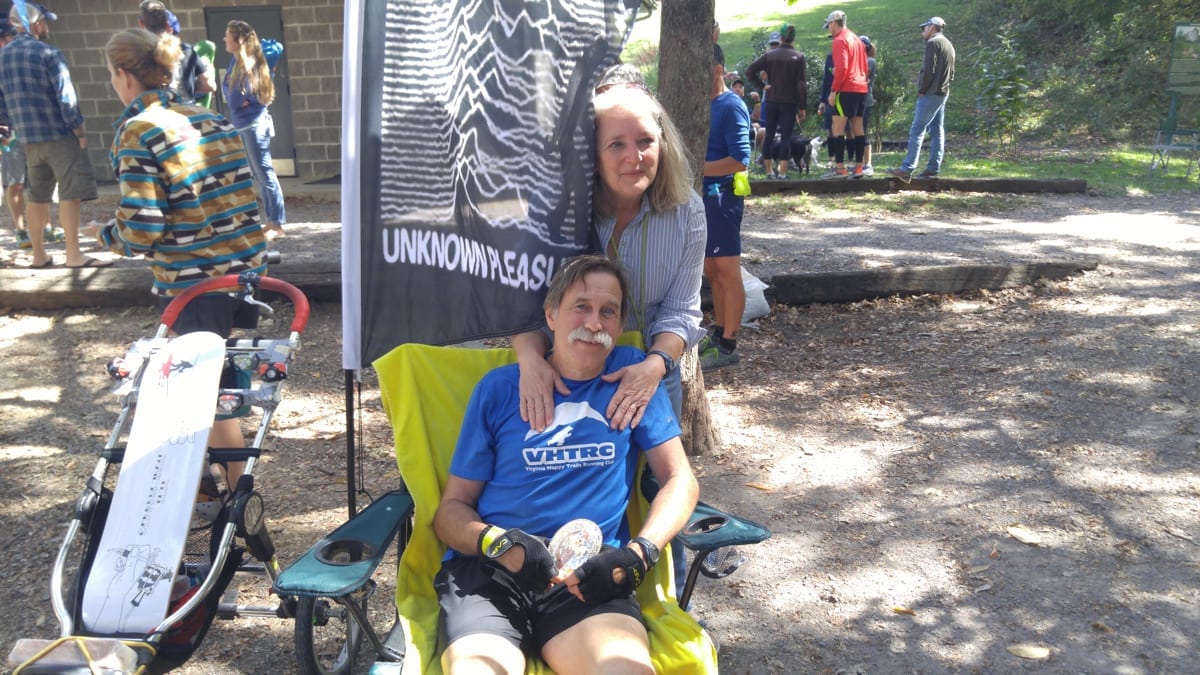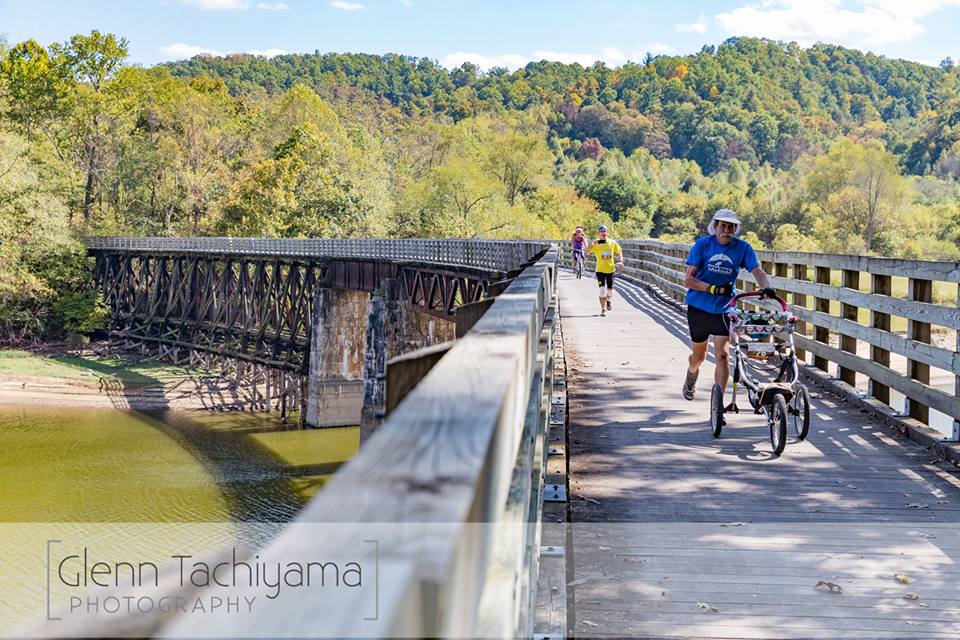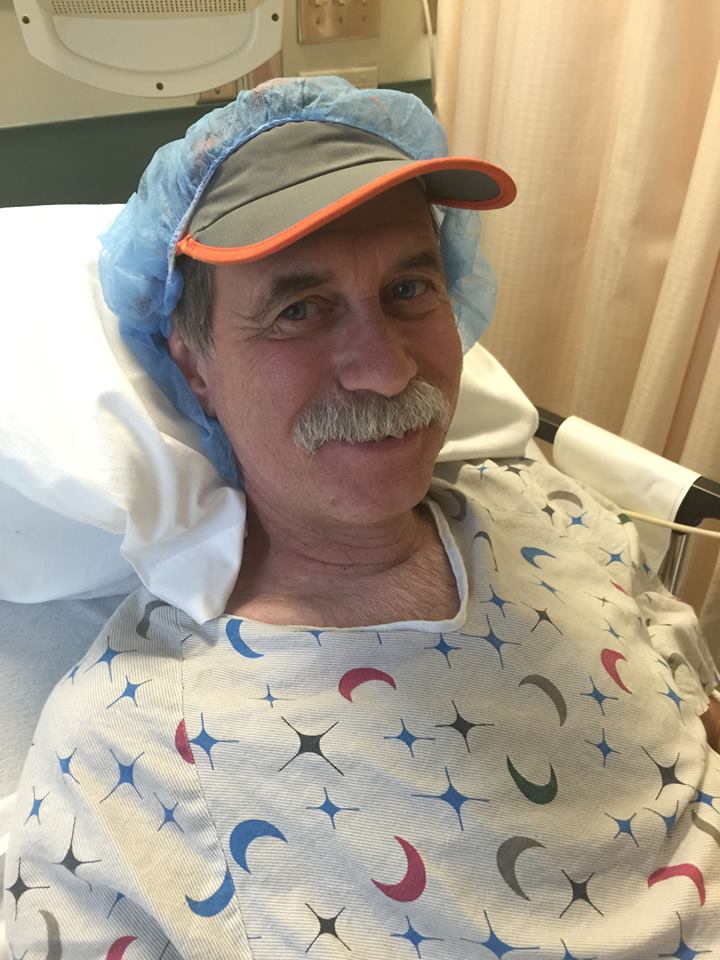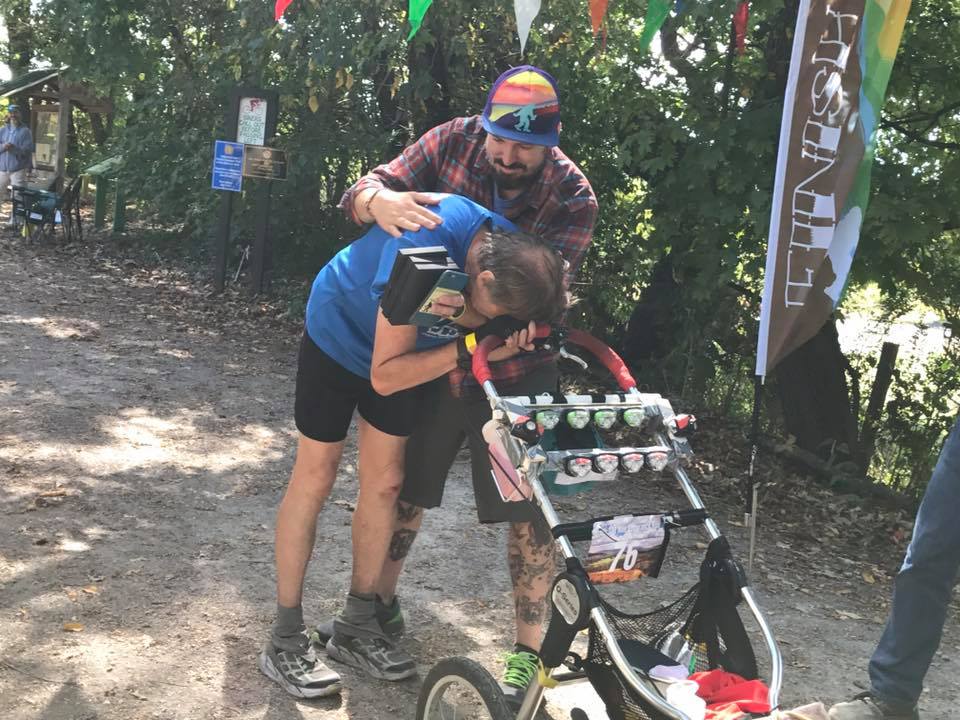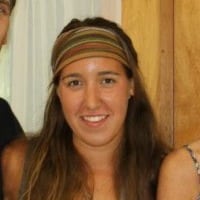“Every runner has a story.”
Tom Green sent this reply to someone asking advice for an upcoming race, reminding them to both enjoy the day and learn a bit about why their fellow runners were also on the trail.
If you were to see a runner arrive at the finish line minutes before the cutoff, gripping a baby jogger as tears stream down his face, what do you think that runner’s story is?
You could say that Tom Green’s story started when he became the first finisher of the race series we now call The Grand Slam of Ultrarunning. You could also say that his story begins long before that. We have to start somewhere, so we’ll begin where ultrarunning really took hold of Tom.
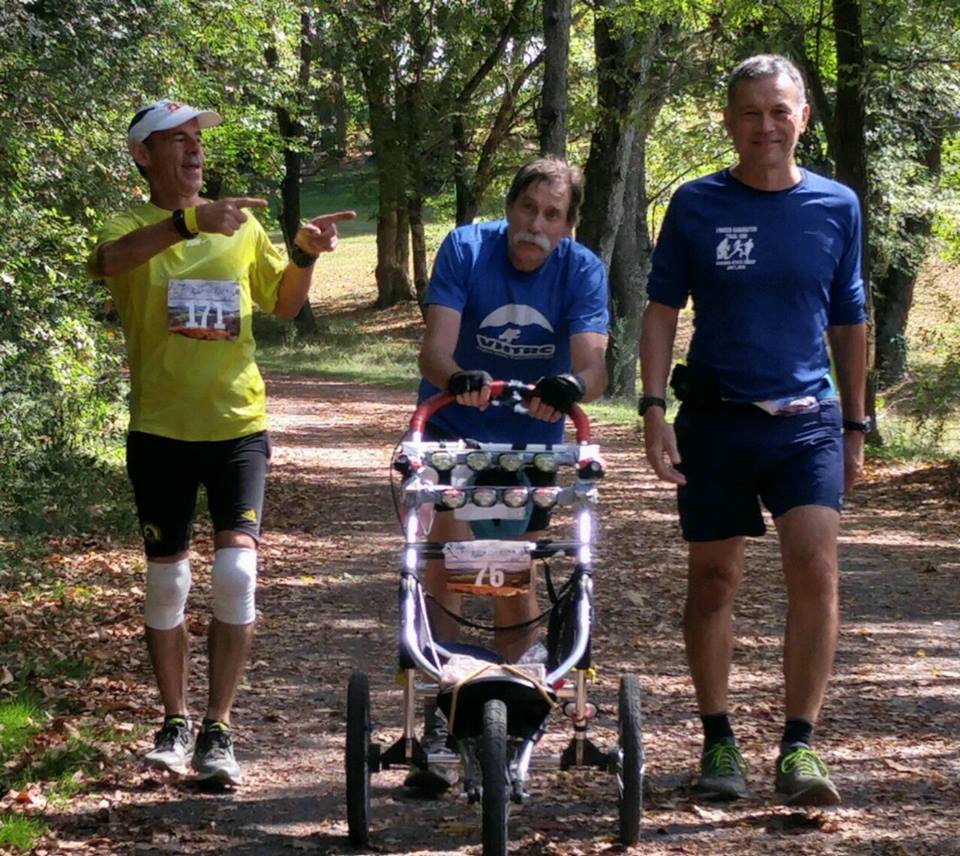
Tom Green (center) running the 2017 Yeti 100 Mile with friends Alan Doss (right) and Charlie Romanello. Photo: Leslie Ames
A grand slam in baseball requires hitting a home run when all three bases are loaded with runners, thereby scoring four runs, the most possible in one play. There is a grand slam in tennis, golf, auto racing, equestrian riding, rugby, chess, and more. So, the term is not new to folks around the world, but when it comes to a grand slam of ultrarunning …
For the first Grand Slam of Ultrarunning series in 1986, it started with the Old Dominion 100 Mile in Virginia. Then, the Western States 100 took place in late June in Olympic Valley, California. Leadville Trail 100 Mile in Colorado was run in mid-August before the final race, Wasatch Front 100 Mile, which was in early September in Utah. The quest encompassed the four oldest 100-mile races in the U.S.
According to Stan Jensen of the Run 100s website, in 1989, the Vermont 100 Mile became an alternate to Old Dominion, as it is also one of the oldest 100 milers. And from 2003 through 2015, Old Dominion was not allowed to be a part of the series. In 2008, due to fires, Western States was canceled and Arkansas Traveller 100 Mile was its replacement. For 2017, Old Dominion was added back to the Grand Slam.
The modern slam requires a runner to finish three among the first four races of the year, Old Dominion, Western States, Vermont, and Leadville. And then all runners must run Wasatch as their fourth race.
Phew.
Over the past few years, about a dozen people begin the year ready to be a slammer. From 1986 to 2017, there have been 345 finishers. Tom Green was finisher #1.
Tom, now 67, was 35 years old when he set out to run the four oldest 100 milers in a single year. He finished all four in a combined time of 96 hours, 26 minutes, and 28 seconds. He ran all 400 miles in a single pair of shoes, with his wife Kay on the sidelines, and a growing group of admiring fans.
He is known as the original Grand Slammer.
“Well, eventually someone else would have done it. Sure, it is always good to be considered the first, but I am certainly not the best runner to do it,” he said. “I just feel good about having chosen a goal like that and stuck with it. I followed through and finished it, which was rather satisfying.”
It is now known that it was Fred Pilon of UltraRunning Magazine who had the idea back in 1985 to run all four 100 milers in one year.
Tom was reading an article in which the author had run all four of the 100-mile races over the years and had compared them. While reading, Tom said the idea to run all four of them in one year popped into his head, and it was a few weeks later that he heard about Pilon’s public announcement. More people began to join the fray of planning.
At this point in his running career, Tom had been attempting ultras for a year, and had DNFed two out of the three 100 milers he had started. Looking at the challenge ahead of him, he began to feel doubt and discouragement. He figured it would be the others who would complete the challenge — and him not finishing yet another 100 miler.
As it turned out, he said with the hint of a chuckle, after the first of the four races, the Old Dominion, there were only six of the original 12 who started, and after the second race, Tom was the only runner left standing.
Tom, now living in Columbia, Maryland, with Kay, was born and raised in Woodstock, Illinois, the town where the movie “Groundhog Day” was filmed. He left the quaint little town to head to Concord University in West Virginia to major in General Studies and run. Entering high school, he had big dreams of becoming a star football player like his older brother.
“[My brother] was captain, had all the girls, and was very popular,” Tom explained. “He steered me into the sport called cross country. ‘All you do is run,’ he had said. He knew I could do better there, so that was what I pursued, even though I was giving up my lucrative NFL career.”
At barely 100 pounds, he added, “I would have gotten killed out there anyway.”
Instead, his four years on the cross-country and track teams were good enough to grant him a decent pick of colleges, choosing to be a vital member of a smaller team.
After college, Tom ran leisurely, but it wasn’t long before he read about a local 10k coming up in his town.
“I had to ask my neighbor how far a 10k was because I didn’t know!” he said. “He said he would do it if I did, so after two weeks of training, we jumped in. I have been running ever since.”
He went through the 10ks, half-marathons, and marathons until he found that times were getting predictable and he was ready for something different.
It was an article in Running Times magazine where Tom first heard about ultras, and seeing pictures of happy, middle-aged, amateur racers complete Old Dominion, he was suckered in.
“I thought, Hey, if these guys can do it, then I can,” he remembered. “I didn’t realize the mental aspect, the determination that some of those people had that I had yet to develop. As soon as I read the article, I showed it to Kay and said, ‘I have to try this.’ It just really appealed to me.”
It was in the mid-1980s when Tom entered his first 100-mile race — because he did not yet know there was anything shorter — Old Dominion.
Two months before the race, Tom called up the race director, asking if he could get into the event.
“He asked if my training mileage was up to 70 miles a week and I assured him it was, when in reality it was closer to 40 miles per week, so I may have fibbed a little,” he said. “But he let me into the race.”
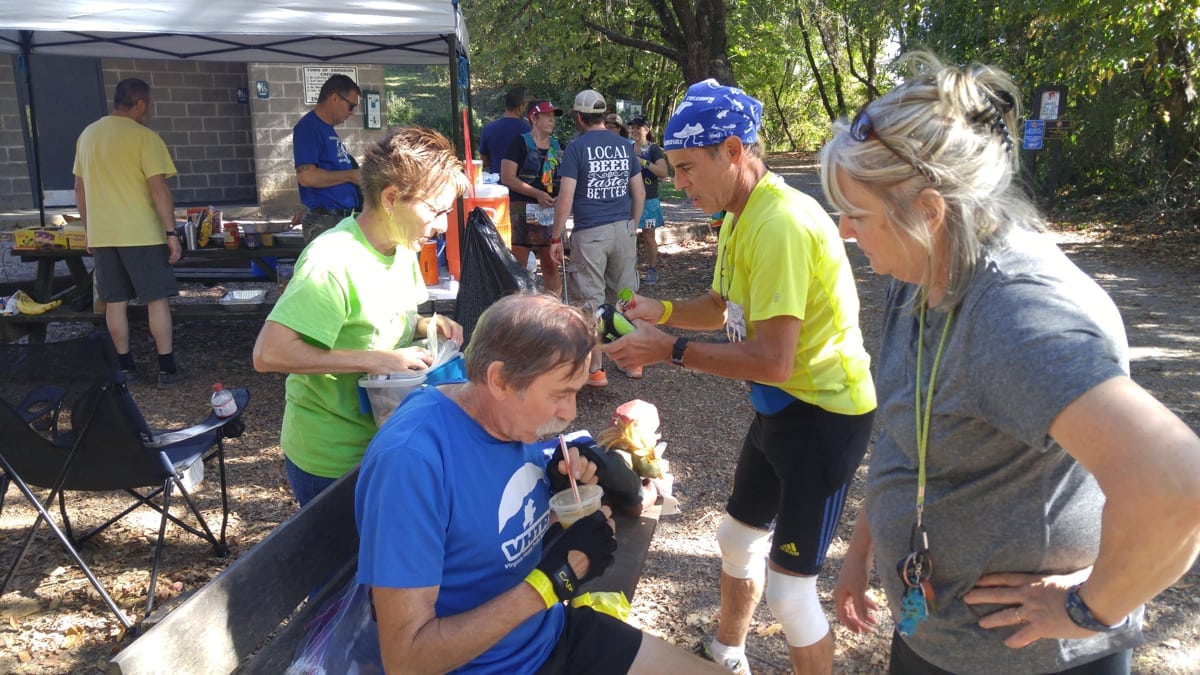
Kay (right), Tom, and Charlie at an aid station during the 2017 Yeti 100 Mile. Photo: Rita and Dick Fuller
So, without any prior experience running trail races and following ribbons, or even running a race of that distance, Tom admits he really had no idea how to run his first 100 miler.
“Eventually I got separated and was running by myself,” he remembers. “I made every mistake in the book — I got lost, I got dehydrated, I wasn’t eating, I tried to make up for lost time in the most heated time of the day. By the time I got to 60 miles, I thought I was going to die.”
Aid-station medics and volunteers recommended that he call it a day at 60 miles due to dehydration, and for the next few days following, Tom said he had no interest in giving it another try. But of course, that quickly changed.
“A few days after the race, I kept thinking about all the mistakes I had made and what I could have done better to finish,” he said. “I started thinking more about it and for the entire next year it was on my mind and just ate on me. I was determined to go back and finish.”
He did go back and when that 60-mile mark came up, Tom said he “felt every bit as bad as he did the previous year.”
Except this year, he hadn’t gotten lost. So, when he came into the 60-mile aid station, he was two hours ahead of last year’s schedule. It was here that another crew member for a runner offered to help Kay in crewing and getting Tom to the finish line.
“Together they talked me into just taking it one aid station at a time and eventually managed to get me to the finish line,” he said.
He finished just under the 24-hour cutoff. That was 1984.
With a successful 100-mile finish, Tom felt really good about returning the next year, in 1985. However, he ended up dropping just a bit further than 60 miles.
“It was rather disappointing,” he said. “That is what led me to the Grand Slam, though it didn’t have a name at that time. I felt so bad about not finishing Old Dominion in ’85 that I vowed to go back and not only finish Old Dominion the next year, I would try to do the other three as well.”
By the finish of the 1986 Western States, the second race of the first-ever Grand Slam, Tom was the only one still going in the quest to complete the slam. And by the third race, Leadville, Tom had attracted a large group of followers watching him attempt what no one had done before.
According to Tom, that year was the easiest Old Dominion race yet and Western States was a bit more difficult, though he was still able to come in under 24 hours.
“Leadville, though,” he said, “I had never run at [high] elevation and it was pretty difficult for me. My flashlight went out on me going over the last mountain climb in the middle of the night and I was 45 minutes by myself trying to find my way in the dark.”
He finished in just over 25 hours. When he lined up for Wasatch, there were even more fans, the Wasatch race director included, who were rooting for Tom to finish.
“The RD had set me up with various runners to take me out and show me the entire course so I wouldn’t get lost,” Tom explained. “He really wanted me to finish.”
With the 36-hour limit, Tom had no worries about finishing. Looking back on it, it is hard to compare them to each other since they all contain such different qualities.
“I am partial to Old Dominion because it was my first 100 and it is so lush and green. Western States is just truly amazing to be a part of the top runners in the county and with all the hype and glitz, it is probably the most prestigious of all 100s,” he explained.
“Leadville is just brutal going over that double crossing of Hope Pass and the elevation. And Wasatch has got a little bit of everything with the gnarliest trails and the prettiest views. It is hard to pick a favorite.”
For each race, Kay was at his side, crewing and cheering him on, even at the finish of Wasatch, which happened to be the date of their anniversary.
“It probably wasn’t the way she thought she would be spending her anniversary, but it made it memorable,” he admitted. “She thought this whole thing was just going to be another big idea that would not come to pass. I think she thought I would give it up somewhere along the way and not continue through four races and she certainly did not think it would continue for another 30 years!”
Yes, for the next 30 years, Tom ran races of all distances, yet that first year after the Grand Slam, he had trouble running much at all. Typically, he ran four to five days a week and no more than 50 miles a week. Even when training for the Grand Slam year, the only thing he changed for training was to stay more in shape during the winter, rather than take a break in the cold months. But he had trouble picking up where he left off.
“I just couldn’t get motivated,” he said. “My race times were slower than they ever were and it wasn’t until the next fall when I started to get motivated enough to start running again. Without that major goal to shoot for, it was hard to push myself.”
Over the next few years, Tom would intentionally not do the Grand Slam again. He would finish two or three of the big races and purposefully not run the fourth, leaving the next step — to repeat the Grand Slam — for another runner.
“I just wanted to do it once and leave it at that,” he said.
Tom continued to race different 100s until he developed an Achilles issue and was forced to take an eight-year drought of no 100-mile finishes. It was either stop running or have Achilles reconstruction surgery. After a long recovery from that, he was able to resume his 100-mile races.
He explained, “I had been able to do 50k and 50-mile races by learning to do it without pushing off the right heel. I could not use the right calf muscle, so if you can imagine what it looked like, me gimping along. It was a pretty odd form.”
The Achilles surgery was in 2008 and he returned to running within a few months. Seven years later, Tom once again suffered from an injury that cost him much more than a few lost miles.
On April 20, 2015, Tom was hit in the back of the head by a large tree branch during a freak accident that almost killed him.
He and friend Alan Doss were working out in his yard, replacing a fence. They happened to take a few minutes from their work to cut down a tree branch that had been brushing the side of his roof and chewing up shingles. The duo broke away the branch and either because the branch was curved or it hit a part of uneven ground, the heavier side of the tree hit the ground and forced the opposite end up.
“It hit me across the back of the head, my friend said, ‘Like a baseball bat.’ And that’s all I remembered for a month.”
Tom spent nearly two months in a hospital bed and another three months in a wheelchair. He suffered skull fractures, and with the destruction of his inner ear, he had hearing loss. He damaged a major artery and blood clots triggered a stroke, which resulted in balance issues.
Tom was forced to relearn how to walk, and the stroke affected his right side so that he couldn’t move his right arm for a month. Today, the use of his right arm and leg is still weakened.
The realization that he probably would never run again did not truly hit him for a while, since he was focused more on just getting his feet to take a few steps before someone had to catch him.
“It was apparent I would never be running like I used to,” he said.
After he was released from the hospital, Tom started his long road of recovery with a three-pronged walker, making it from his driveway to the neighbor’s house and back. Then after a few days, it was to the second mailbox and back. Then the third and back, and so on.
It would be two months before Tom could walk an entire mile, and during that time he realized he needed something that would be easier and faster to walk with. He tried out a walker with wheels, but quickly switched to a baby jogger, which allowed him to turn walking into jogging.
By the fall of 2015, Tom was jogging enough to aim for yet another lofty goal. He wanted to race another ultramarathon.
He managed to finish more than a 50k during a timed 24-hour event, so the next year he upped it to 50 miles.
“I thought, If I can do a 50-mile race at sub-30-hour pace, maybe I can condition myself to finish 100 miles. That’s what I set my goals on,” he said.
Tom entered two races: first, the Yeti 100 Mile in the fall of 2017 and the other, the 2018 Umstead 100 Mile, in hopes that he would finish at least one. It just so happens that he already has.
Tom came to the finish line of the 2017 Yeti 100 Mile after 29 hours and 46 minutes of walking and jogging with the baby jogger, crossing in a wave of emotions and relief. With the help of friends Charlie Romanello and Alan, and his wife, Tom was able to make every cutoff.
Romanello actually flew out from California to run his first ultra with Tom after hearing about his friend’s goal.
“As you may know, after Tom’s accident, he set a goal to complete a 100 miler,” Romanello said. “At the same time, I made a personal commitment to do whatever I could to help him achieve that goal. So when Yeti 2017 registration opened, I decided to not only pace Tom, but to try and run the entire race with him. I thought, What better way to provide support than to be by his side for every mile, and not just miles 42 to 100.”
According to Romanello, Tom “the machine” never complained even during the night, when his lack of balance caused the most difficulty for him. As the miles ticked by, Romanello said it was never a question of whether he would finish, it was when, as they focused on making each cutoff.
“As the countdown continued, from mile 10, to nine, to eight … we kept checking in with Tom. He was saying very little at this point, but his pace was not slowing. I think we were covering each mile in the 16s and 17s [minutes per mile],” Romanello explained.
“I recall asking Tom how he was doing, and if he was going to make it. His answer was always the same: ‘I’ll tell you at mile marker 1.’ When we passed the final mile marker, I caught a faint smile come across Tom’s face. I’ve never told him that I had seen that. I think the last of the final 10 miles was his fastest, and probably his happiest.”
There was applause and tears from fans, both those that knew about Tom’s long journey of recovery and those who did not. He came in just minutes from the final cutoff, as Tom is apt to do.
For him, crossing that finish line was an experience beyond description.
“It was just amazing. It was really a long time coming. It wasn’t that you trained a few months to run, but instead it was coming back after a hospital bed, relearning to walk for two and a half years, and working up to this,” Tom explained. “I was pretty emotional to finally finish.”
He also just wanted to cross the finish line at one more 100-mile race.
“I also realized that it was probably going to be my last 100 I’ll ever do,” he added. “That added to the emotion of it.”
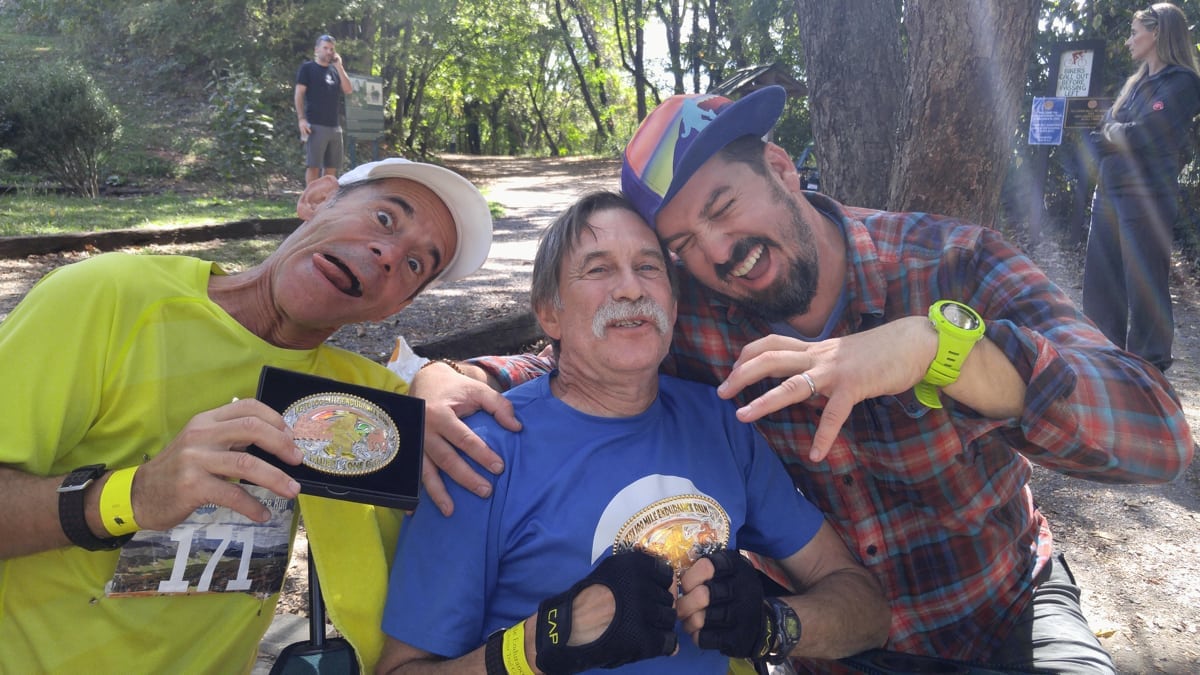
Tom, Charlie, and Yeti 100 Mile Race Director Jason Green celebrating at the end of the race. Photo: Rita and Dick Fuller
Race director Jason Green caught that emotion on video and when it comes to his friend, there are only two words to describe him: grit and determination.
“He sent me a message two weeks before: ‘I’ve been averaging five miles a week, no doubt I will finish the Yeti.’ When someone sends me a message like that, then I had no doubt I would see him there. I did not question it,” Jason Green recalled.
“With Tom, he may not be the most talented runner, but you know that if you’re ever in a race and shit went down, but Tom was around, then you at least know you’re going to see the finish line.”
Tom continues to be an inspiration to those on the Yeti course and according to the director, “He is part of the race now.”
Tom has accepted that his incredible Yeti finish may be the last 100-mile race. However, he is still signed up for next spring’s Umstead 100 Mile, making that race either his last 100 or last 100-mile attempt.
Tom’s life can be easily described as a rollercoaster of ups and downs and highs and lows, yet his drive and outlook on life never wavers.
Now, with more than three decades gone by since the inaugural Grand Slam, many people are lining up to seek the veteran’s advice for their own running goals.
“I do feel kind of honored that they single me out to ask for advice, but a lot of times that is a personal thing,” he said. “It does make me feel good to talk with people and if I can help them, I do.”
When one new ultrarunner left a message on Tom’s Facebook page about how to prepare for his first ultra, Tom quickly responded.
“The most important bit of advice I would give would be to try and make it a positive experience. Run within your ability. Enjoy the day. Lastly, take the effort to get to know the other runners. Every runner has a story.”
By golly, does Tom Green have a story!
[Author’s Note: For more on Tom Green, read Neal Gorman’s article “The First Grand Slammer.”]
Call for Comments (from Meghan)
All right, here we go. It’s story time! Did you follow that first Grand Slam of Ultrarunning? Have you run with Tom at his many more than 200 ultramarathons over the years? Have you crewed at a race with Kay? Leave a comment to share your Tom and Kay Green stories.
